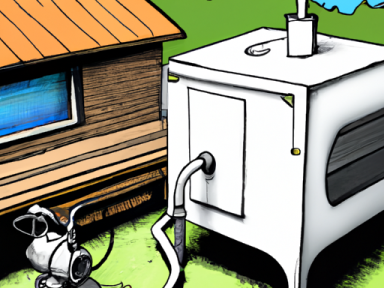
Are you prepared for a power outage? What if you were faced with a long-term grid failure? How would you cook your food? Heat your home? Power your essential equipment?
In today’s uncertain times, being self-reliant is more important than ever. Having alternative energy sources can mean the difference between survival and struggle. And that’s where homemade biogas generators come into play.
Biogas is a renewable energy source that can be generated from organic waste. It’s a mixture of methane and carbon dioxide, produced through the process of anaerobic digestion. By harnessing the power of biogas, you can fuel your off-grid needs, reduce your dependence on fossil fuels, and do your part to protect the environment.
Why choose a homemade biogas generator?
Commercial biogas generators can be expensive and may not be accessible to everyone. That’s where the beauty of a homemade biogas generator lies. With some basic materials and a little bit of know-how, you can create your own biogas system at a fraction of the cost.
Homemade biogas generators are a sustainable and practical solution for those seeking self-reliance. They provide a constant supply of clean energy without relying on external sources. By utilizing organic waste, such as kitchen scraps, animal manure, or garden trimmings, you can create a valuable resource.
How to create a homemade biogas generator
Creating your own biogas generator may sound complicated, but it’s actually quite simple. Here’s a step-by-step guide to get you started:
- Choose the right container: Look for a sturdy container that can hold the organic waste and gas. A 55-gallon drum or a large plastic tank works well for this purpose.
- Create an inlet and outlet: Drill a hole near the bottom of the container for the gas outlet. Another hole near the top will serve as the inlet for the organic waste.
- Add organic waste: Start by adding a mixture of organic waste, such as kitchen scraps, animal manure, or plant debris, into the container. Fill it up, leaving some room for gas expansion.
- Seal the container: Use airtight materials, such as rubber gaskets or silicone, to seal the container. This will ensure that the gas doesn’t escape and can be directed towards your desired use.
- Attach a gas collection system: Connect a hose or pipe to the gas outlet and lead it to the area where you need the gas. This could be a stove, heater, or generator.
- Let it ferment: Leave the container undisturbed for several weeks to allow the organic waste to ferment. This process will produce biogas.
- Use the biogas: Once you start seeing bubbles in the gas outlet, it’s a sign that the biogas is being produced. You can now connect your appliance and enjoy the benefits of homemade biogas.
The benefits of homemade biogas generators
Investing your time and effort in creating a homemade biogas generator offers numerous advantages:
- Energy independence: By generating your own biogas, you become less reliant on external energy sources and more self-sufficient.
- Environmental friendliness: Biogas is a renewable energy source that reduces greenhouse gas emissions and helps combat climate change.
- Cost-effective: Homemade biogas systems require minimal investment and can provide significant savings on energy bills in the long run.
- Avoid waste: Instead of throwing away organic waste, you can put it to good use and turn it into valuable energy.
- Alternative cooking fuel: Biogas can be used as a cooking fuel, providing a reliable and sustainable option, particularly in emergency situations.
Conclusion
As the world becomes increasingly uncertain, it’s crucial to prepare for all eventualities. Creating a homemade biogas generator is a proactive step towards self-reliance and sustainability. By harnessing the power of organic waste, you can generate clean energy for your off-grid needs, reduce your carbon footprint, and ensure a reliable source of energy in times of crisis.
So, why wait? Start your biogas journey today and take control of your energy future.



GIPHY App Key not set. Please check settings